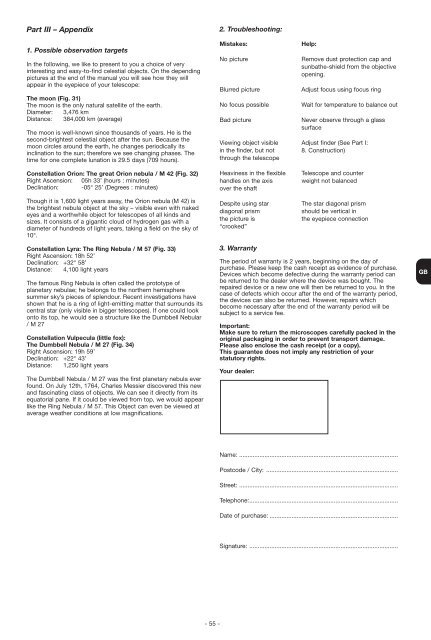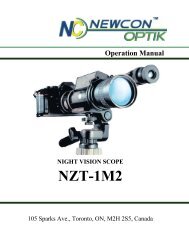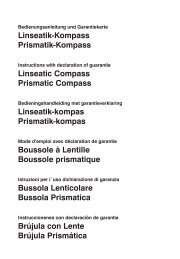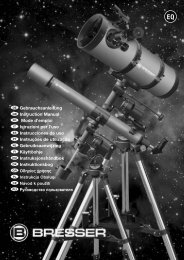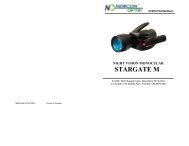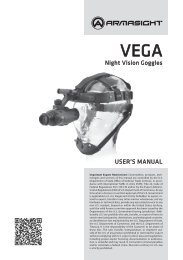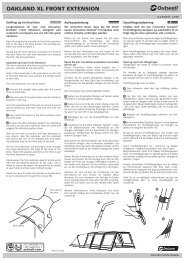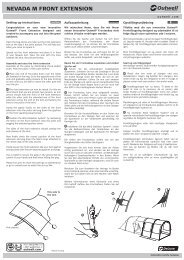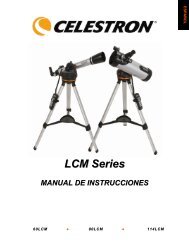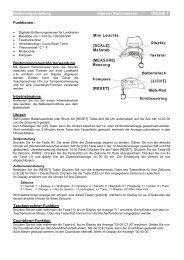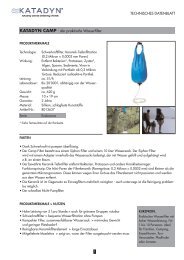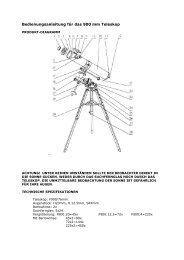Manual de instrucciones
Manual de instrucciones
Manual de instrucciones
You also want an ePaper? Increase the reach of your titles
YUMPU automatically turns print PDFs into web optimized ePapers that Google loves.
Part III – Appendix<br />
1. Possible observation targets<br />
In the following, we like to present to you a choice of very<br />
interesting and easy-to-find celestial objects. On the <strong>de</strong>pending<br />
pictures at the end of the manual you will see how they will<br />
appear in the eyepiece of your telescope:<br />
The moon (Fig. 31)<br />
The moon is the only natural satellite of the earth.<br />
Diameter: 3,476 km<br />
Distance: 384,000 km (average)<br />
The moon is well-known since thousands of years. He is the<br />
second-brightest celestial object after the sun. Because the<br />
moon circles around the earth, he changes periodically its<br />
inclination to the sun; therefore we see changing phases. The<br />
time for one complete lunation is 29.5 days (709 hours).<br />
Constellation Orion: The great Orion nebula / M 42 (Fig. 32)<br />
Right Ascension: 05h 33’ (hours : minutes)<br />
Declination: -05° 25’ (Degrees : minutes)<br />
Though it is 1,600 light years away, the Orion nebula (M 42) is<br />
the brightest nebula object at the sky – visible even with naked<br />
eyes and a worthwhile object for telescopes of all kinds and<br />
sizes. It consists of a gigantic cloud of hydrogen gas with a<br />
diameter of hundreds of light years, taking a field on the sky of<br />
10°.<br />
Constellation Lyra: The Ring Nebula / M 57 (Fig. 33)<br />
Right Ascension: 18h 52’<br />
Declination: +32° 58’<br />
Distance: 4,100 light years<br />
The famous Ring Nebula is often called the prototype of<br />
planetary nebulae; he belongs to the northern hemisphere<br />
summer sky’s pieces of splendour. Recent investigations have<br />
shown that he is a ring of light-emitting matter that surrounds its<br />
central star (only visible in bigger telescopes). If one could look<br />
onto its top, he would see a structure like the Dumbbell Nebular<br />
/ M 27<br />
Constellation Vulpecula (little fox):<br />
The Dumbbell Nebula / M 27 (Fig. 34)<br />
Right Ascension: 19h 59’<br />
Declination: +22° 43’<br />
Distance: 1,250 light years<br />
The Dumbbell Nebula / M 27 was the first planetary nebula ever<br />
found. On July 12th, 1764, Charles Messier discovered this new<br />
and fascinating class of objects. We can see it directly from its<br />
equatorial pane. If it could be viewed from top, we would appear<br />
like the Ring Nebula / M 57. This Object can even be viewed at<br />
average weather conditions at low magnifications.<br />
- 55 -<br />
2. Troubleshooting:<br />
Mistakes: Help:<br />
No picture Remove dust protection cap and<br />
sunbathe-shield from the objective<br />
opening.<br />
Blurred picture Adjust focus using focus ring<br />
No focus possible Wait for temperature to balance out<br />
Bad picture Never observe through a glass<br />
surface<br />
Viewing object visible Adjust fin<strong>de</strong>r (See Part I:<br />
in the fin<strong>de</strong>r, but not 8. Construction)<br />
through the telescope<br />
Heaviness in the flexible Telescope and counter<br />
handles on the axis weight not balanced<br />
over the shaft<br />
Despite using star The star diagonal prism<br />
diagonal prism should be vertical in<br />
the picture is the eyepiece connection<br />
“crooked”<br />
3. Warranty<br />
The period of warranty is 2 years, beginning on the day of<br />
purchase. Please keep the cash receipt as evi<strong>de</strong>nce of purchase.<br />
Devices which become <strong>de</strong>fective during the warranty period can<br />
be returned to the <strong>de</strong>aler where the <strong>de</strong>vice was bought. The<br />
repaired <strong>de</strong>vice or a new one will then be returned to you. In the<br />
case of <strong>de</strong>fects which occur after the end of the warranty period,<br />
the <strong>de</strong>vices can also be returned. However, repairs which<br />
become necessary after the end of the warranty period will be<br />
subject to a service fee.<br />
Important:<br />
Make sure to return the microscopes carefully packed in the<br />
original packaging in or<strong>de</strong>r to prevent transport damage.<br />
Please also enclose the cash receipt (or a copy).<br />
This guarantee does not imply any restriction of your<br />
statutory rights.<br />
Your <strong>de</strong>aler:<br />
Name: ..............................................................................................<br />
Postco<strong>de</strong> / City: ..............................................................................<br />
Street: ..............................................................................................<br />
Telephone:........................................................................................<br />
Date of purchase: ............................................................................<br />
Signature: ........................................................................................<br />
GB


